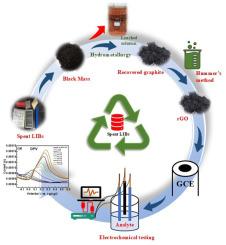废物传感器:将锂离子电池用过的石墨重新利用成还原氧化石墨烯,用于抗坏血酸的电化学检测
IF 10.9
1区 环境科学与生态学
Q1 ENGINEERING, ENVIRONMENTAL
引用次数: 0
摘要
使用过的锂离子电池(s - lib)在其生命周期结束后通常被丢弃在垃圾填埋场,尽管其中含有石墨等有价值的材料。虽然许多研究都集中在从阴极中提取贵金属,但本研究探索了废石墨的回收、回收和再利用,将其转化为还原氧化石墨烯(rGO)用于电化学传感。在pH 7.6下,还原氧化石墨烯材料对抗坏血酸(AA)的浓度范围为1 mM至100 mM,具有优异的灵敏度,为AA检测提供了一种经济有效的解决方案。从s - lib和商业石墨中回收的石墨(RG)首先转化为氧化石墨烯(R-GO, C-GO),然后还原(R-rGO, C-rGO)。利用粉末x射线衍射(PXRD)、拉曼光谱、x射线光电子能谱(XPS)、布鲁诺尔-埃米特-泰勒(BET)分析、场发射扫描电子显微镜(FE-SEM)和高分辨率透射电子显微镜(HR-TEM)等技术对这种材料进行了广泛的结构表征。通过循环伏安法(CV)、差分脉冲伏安法(DPV)评价电化学性能。这项研究强调了“废物转化财富”的概念,并通过将电子废物转化为有价值的资源来支持循环经济原则。R-rGO和C-rGO材料的LOD和LOQ分别为3.055 mM、10.18 mM和3.41 mM、11.36 mM。基于rgo的传感器不仅促进了可持续回收,而且为抗坏血酸检测提供了低成本,高性能的解决方案,在食品质量监测,医疗诊断和化妆品行业具有潜在的应用前景。本文章由计算机程序翻译,如有差异,请以英文原文为准。

Waste-to-sensor: Repurposing spent Li-ion battery graphite into reduced graphene oxide for electrochemical detection of ascorbic acid
Spent lithium-ion batteries (S-LIBs) are typically discarded in landfills after their lifecycle ends, despite containing valuable materials like graphite. While much research focuses on extracting precious metals from the cathode, this study explores the recycling, recovery, and reuse of spent graphite, converting it into reduced graphene oxide (rGO) for electrochemical sensing. The rGO material demonstrated excellent sensitivity to ascorbic acid (AA) in a concentration range of 1 mM to 100 mM at pH 7.6, offering a cost-effective solution for AA detection. The recovered graphite (RG) from S-LIBs and commercial graphite (CG) was first converted into graphene oxide (R-GO, C-GO) and then reduced (R-rGO, C-rGO). This material underwent extensive structural characterization using techniques such as powder X-ray diffraction (PXRD), Raman spectroscopy, X-ray photoelectron spectroscopy (XPS), Brunauer-Emmett-Teller (BET) analysis, field-emission scanning electron microscopy (FE-SEM), and high-resolution transmission electron microscopy (HR-TEM). Electrochemical performance was evaluated through cyclic voltammetry (CV), differential pulse voltammetry (DPV). This study underscores the "waste-to-wealth" concept and supports circular economy principles by transforming electronic waste into a valuable resource. The LOD and LOQ for both the material R-rGO and C-rGO were calculated as 3.055 mM, 10.18 mM, and 3.41 mM, 11.36 mM, respectively. The rGO-based sensor not only promotes sustainable recycling but also offers a low-cost, high-performance solution for ascorbic acid detection, with potential applications in food quality monitoring, medical diagnostics, and the cosmetic industry.
求助全文
通过发布文献求助,成功后即可免费获取论文全文。
去求助
来源期刊

Resources Conservation and Recycling
环境科学-工程:环境
CiteScore
22.90
自引率
6.10%
发文量
625
审稿时长
23 days
期刊介绍:
The journal Resources, Conservation & Recycling welcomes contributions from research, which consider sustainable management and conservation of resources. The journal prioritizes understanding the transformation processes crucial for transitioning toward more sustainable production and consumption systems. It highlights technological, economic, institutional, and policy aspects related to specific resource management practices such as conservation, recycling, and resource substitution, as well as broader strategies like improving resource productivity and restructuring production and consumption patterns.
Contributions may address regional, national, or international scales and can range from individual resources or technologies to entire sectors or systems. Authors are encouraged to explore scientific and methodological issues alongside practical, environmental, and economic implications. However, manuscripts focusing solely on laboratory experiments without discussing their broader implications will not be considered for publication in the journal.
 求助内容:
求助内容: 应助结果提醒方式:
应助结果提醒方式:


